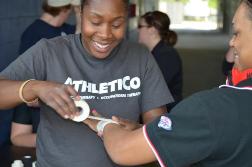
Behind the Lines of Prepping for the Big Game
Leave a CommentToday’s post was co-authored by Joey Brutzkus, ATC – intern with the Chicago Bears in 2010
Keeping players healthy in the NFL is tough enough under normal circumstances, but the distractions and change of venue for the Super Bowl can make that an even bigger challenge. Luckily, athletic trainers are used to working in foreign environments under quickly changing conditions.
Remaining flexible as an athletic trainer is key to any successful trip. Players and athletic trainers are taken away from their normal routine and facilities, so adapting quickly and planning ahead is a must. It’s not uncommon for athletic training staffs to have Super Bowl logistics in place before the NFC and AFC championship games even kickoff. To facilitate as much normalcy as possible, an athletic trainer or two will typically travel to the host city ahead of time to set up and get a lay of the land. Preparing an athletic training room might not sound like a huge task, but you can count on an NFL team sending about 9-10 trunks full of equipment and supplies, with each trunk being about 4 times the size of your typical piece of luggage. The baggage fees must cost as much as 30 seconds of Super Bowl ad time.
 Once everyone arrives in the host city, the real work begins. A typical day begins with treatments early in the morning. These treatments typically include rehabilitation for injuries, stretching, massages, and using modalities like ultrasound and electrical stimulation to facilitate healing. These treatments will occur 2-3 times per day; morning, noon, and night. The first day or two will typically just be treatments as the teams are scheduled to be with the media for extensive interviews most of the day. When the media days are finished, the teams will usually get 3 full practices before the big game, so athletic trainers will be around an hour beforehand evaluating progress on injuries, taping (over 100 ankles alone), stretching, manual therapy, and preparing athletes as well as an hour afterwards evaluating new injuries, more stretching, manual therapy, and icing. Time between treatments and practices is split between personal time and resolving random issues that arise with the team – illness, forgotten medications, etc.
Once everyone arrives in the host city, the real work begins. A typical day begins with treatments early in the morning. These treatments typically include rehabilitation for injuries, stretching, massages, and using modalities like ultrasound and electrical stimulation to facilitate healing. These treatments will occur 2-3 times per day; morning, noon, and night. The first day or two will typically just be treatments as the teams are scheduled to be with the media for extensive interviews most of the day. When the media days are finished, the teams will usually get 3 full practices before the big game, so athletic trainers will be around an hour beforehand evaluating progress on injuries, taping (over 100 ankles alone), stretching, manual therapy, and preparing athletes as well as an hour afterwards evaluating new injuries, more stretching, manual therapy, and icing. Time between treatments and practices is split between personal time and resolving random issues that arise with the team – illness, forgotten medications, etc.
Game day is about as close as it gets to a normal routine for the athletic trainers and their athletes. Another round of treatments and a bus ride are all that separate the alarm clock from heading to the stadium to get ready for kickoff. The athletic training staff will be there about 5 hours before game time, making sure all goes smoothly so everyone can focus on the game. Once the game begins, it’s business as usual for everyone involved, with the staff divvying up duties of watching the game for new injuries, sideline injury evaluations, impromptu tapings, and providing manual therapy for any players that need it during the game. When the final horn sounds, it’s not unusual for some of the athletic training staff to miss the celebration as they’re already in the athletic training room preparing to evaluate, ice, and treat anyone that needs it after the game.
No matter which team wins or loses, each athletic training staff is heading towards the off-season. For some of the staff, this means some time off, while its business as usual for the rest of the staff as the off season is full of injury follow-ups and implementation of strength & conditioning programs. At this point for the athletic training staff, the NFL Scouting Combine is only a few weeks away and the momentum of a new season begins behind the scenes.
For more information about Athletico’s Athletic Training Outreach, please click here.
